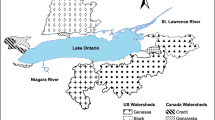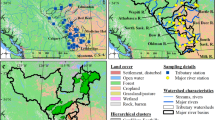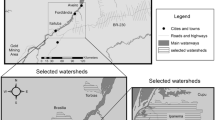Abstract
Seven Wisconsin rivers with contrasting, relativelyhomogeneous watershed composition were selected toassess the factors controlling mercury transport.Together, these watersheds allow comparisons ofwetland, forest, urban and agricultural land-uses.Each site was sampled nine times between September1993 and September 1994 to establish seasonalsignatures and transport processes of total mercury(HgT) and methylmercury (MeHg). Our resultsclearly show that land use and land cover stronglyinfluence mercury transport processes. Under base-flowconditions, unfiltered MeHg yield varies by a factorof sixteen (12–195 mg km-2 d-1), andincreases with the fraction of wetland area in thewatershed. Elevated mercury yields during high floware particle-phase associated in agricultural sites,but filtered-phase associated in wetland sites.Methylmercury represented less than 5% of totalmercury mobilized during the spring thaw across allwatersheds. Autumn MeHg yield was generally 11–15%of HgT in wetland influenced watersheds, thougha maximum of 51% was observed. In some cases, singlehigh-flow events may dominate the annual export ofmercury from a watershed. For example, one high-flowevent on the agricultural Rattlesnake Creek had thelargest HgT and MeHg yield in the study (107 and2.32 mg km-2 d-1, respectively). The mass ofmercury transported downstream by this single eventwas an order of magnitude larger than the eight other(non-event) sampling dates combined. These resultsunderscore the importance of watershed characteristicsand seasonal events on the fate of mercury in freshwater rivers.
Similar content being viewed by others
References
Andren AW & Harriss RC (1975) Observations on the association between mercury and organic matter dissolved in natural waters. Geochimica et Cosmochimica Acta 39: 1253–1257
Babiarz CL & Andren AW (1995) Total concentrations of mercury in Wisconsin (USA) lakes and rivers. Water Air Soil Pollut. 83: 173–183
Balogh SJ, Meyer ML, & Johnson DK (1997) Mercury and suspended sediment loadings in the lower Minnesota River. Environ. Sci. Technol. 31: 198–202
Benoit G, Oktay-Marshall SD, Cantu II, A, Hood EM, Coleman CH, Corapcioglu MO & Santschi PH (1994) Partitioning of Cu, Pb, Ag, Zn, Fe, Al and Mn between filter-retained particles, colloids, and solution in six Texas estuaries. Marine Chem. 45: 307–336
Bloom NS & Crecelius EA (1983) Determination of mercury in seawater at sub-nanogram per liter levels. Marine Chem. 14: 49–59
Bloom NS (1989) Determination of picogram levels of methylmercury by aqueous phase ethylation, followed by cryogenic gas chromatography with cold vapour atomic fluorescence detection. Can. J. Fish. Aquat. Sci. 46: 1131–1140
Branfireun BA, Heyes A & Roulet NT (1996) The hydrology and methylmercury dynamics of a Precambrian Shield headwater peatland. Water Resour. Res. 32(6): 1785–1794
Gill GA & Fitzgerald WF (1985) Mercury sampling of open ocean waters at the picomolar level. Deep-Sea Res. 32(3): 287–297
Gill GA, & Bruland KW (1990) Mercury speciation in surface freshwater systems in California and other areas. Environ. Sci. Technol. 24(9): 1392–1400
Grondin A, Lucotte M, Mucci A & Fortin B (1995) Mercury and lead profiles and burdens in soils of Quebec (Canada) before and after flooding. Can. J. Fish. Aquat. Sci. 52: 2493–2506
Horvat M, Liang L & Bloom NS (1993) Comparison of distillation with other current isolation methods for the determination of methyl mercury compounds in low level environmental samples: Part II, Water. Anal. Chim. Acta 282: 153–168
Hurley, JP, Krabbenhoft DP, Babiarz CL & Andren AW (1994) Cycling of mercury across the sediment-water interface in seepage lakes. In: Baker LA (Ed) Environmental Chemistry of Lakes and Reservoirs (pp 425–44). American Chemical Society, Publishers, Washington, DC
Hurley JP, Benoit JM, Babiarz CL, Shafer MM, Andren AW, Sullivan JR, Hammond R & Webb DA (1995) Influences of watershed characteristics on mercury levels in Wisconsin rivers. Environ. Sci. Technol. 29(7): 1867–1875
Hurley JP, Shafer MM, Cowell SE, Overdier JT, Hughes PE & Armstrong DE (1996) Trace metal assessment of Lake Michigan tributaries using low-level techniques. Environ. Sci. Technol. 30(6): 2093–2098
Kelly CA, Rudd JWM, St Louis VL & Heyes A (1995) Is total mercury concentration a good predictor of methyl mercury concentration in aquatic systems? Water Air Soil Pollut. 80: 715–724
Liang L, Horvat M & Bloom NS (1994) An improved speciation method for mercury by GC/CVAFS after aqueous phase ethylation and room temperature precollection. Talanta 41(3): 371–379
Lindquist O, Johansson K, Aastrup M, Anderson A, Bringmark L, Hovsenius G, Håkanson L, Iverfeldt È, Meili M & Timm B (1991) Mercury in the Swedish environment – recent research on causes, consequences and corrective methods. Water Air Soil Pollut. 55: 143–177, 187–191
Long DT, Eisenreich SJ & Swackhamer DL (1996) Atmospheric deposition of toxic contaminants to the Great Lakes: Assessment and importance. In: Report to the Great Lakes Protection Fund (vol 3: Metals). Great Lakes Protection Fund, Chicago
Mason RP, Fitzgerald WF & Morel FMM (1994) The biogeochemical cycling of elemental mercury: Anthropogenic influences. Geochimica et Cosmochimica Acta 58(15): 3191–3198
Mason RP & Sullivan KA (1997) Mercury in Lake Michigan. Environ. Sci. Technol. 31(3): 942–947
Mierle G & Ingram R (1991) The role of humic substances in the mobilization of mercury from watersheds. Water Air Soil Pollut. 56: 349–357
Nater EA & Grigal DF (1992) Regional trends in mercury distribution across the Great Lakes states, north central USA. Nature 358: 139–141
Nriagu JO, Lawson G, Wong HKT & Azcue JM (1993) A protocol for minimizing contamination in the analysis of trace metals in Great Lakes waters. J. Great Lakes Res. 19(1): 175–182
Patterson CC & Settle DM (1976) Accuracy in trace analysis: Sampling, sample handling, and analysis. In: Special Publication 422 (pp 321–351). U.S. Bureau of Standards, Washington, DC
Shafer MM, Overdier JT, Hurley JP, Armstrong D & Webb D (1997) The influence of dissolved organic carbon, suspended particulates, and hydrology on the concentration, partitioning and variability of trace metals in two contrasting Wisconsin watersheds (U.S.A.). Chem. Geol. 136: 71–97
Sorenson JA, Glass GE, Schmidt KW, Huber JK & Rapp Jr., GR (1990) Airborne mercury deposition and watershed characteristics in relation to mercury concentrations in water, sediments, plankton and fish of eighty northern Minnesota lakes. Environ. Sci. Technol. 24(11): 1716–1727
St. Louis VL, Rudd JWM, Kelly CA, Beaty KG, Bloom NS & Flett RJ (1994) Importance of wetlands as sources of methyl mercury to Boreal forest ecosystems. Can. J. Fish. Aquat. Sci. 51: 1065–1076
St. Louis VL, Rudd JWM, Kelly CA, Beaty KG, Flett RJ & Roulet NT (1996) Production and loss of methylmercury and loss of total mercury from Boreal forest catchments containing different types of wetlands. Environ. Sci. Technol. 30(9) 2719–2729
United States Geological Survey (1963) Interagency Committee on Water Resources: Determination of Fluvial Discharge. U.S.G.S., Minneapolis, Minnesota.
United States Geological Survey (1994) Water Resource Data; Wisconsin Water Year 1993. U.S.G.S., Madison, Wisconsin.
United States Geological Survey (1995) Water Resource Data; Wisconsin Water Year 1994. U.S.G.S., Madison, Wisconsin.
Zillioux EJ, Porcella DB & Benoit JM (1993) Mercury cycling and effects in freshwater wetland ecosystems. Environ. Toxicol. Chem. 12: 2245–2264
Author information
Authors and Affiliations
Rights and permissions
About this article
Cite this article
Babiarz, C.L., Benoit, J.M., Shafer, M.M. et al. Seasonal influences on partitioning and transport of total and methylmercury in rivers from contrasting watersheds. Biogeochemistry 41, 237–257 (1998). https://doi.org/10.1023/A:1005940630948
Issue Date:
DOI: https://doi.org/10.1023/A:1005940630948




